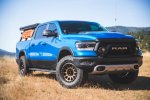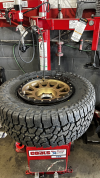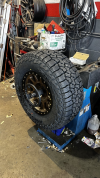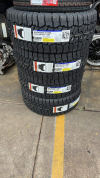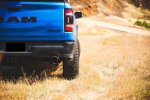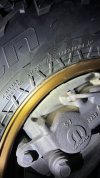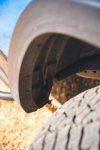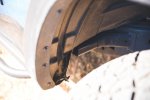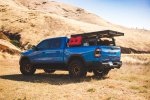boogielander
Spends too much time on here
- Joined
- Jun 29, 2022
- Messages
- 3,088
- Reaction score
- 4,993
- Points
- 113
In this thread, I will be detailing the info regarding the tire choice, suspension choice, and trimming needed.
Note: My procedure involves irreversible modification to the truck, so consult a professional of your choice and proceed at your own risk. This thread is to SHARE HOW I DID mine and is published for informational purpose only, and is NOT a step-by-step guide. The forum (forum team, admins, and mods) and I are NOT responsible for what you decide to do. You are responsible for your actions should you choose to follow my method and screw up something.
Note #2: This is geared toward those who install performance orientated lift kits and offroad their trucks only. If you stay on pavement then the trimming part will be overkill for you.
I chose Wildpeak AT3w for a few reasons:
Rebels came with 33s (275/70R18) stock and I was going to run with the stock ones until they were done. But there's one universal truth: bigger is always better. Not just tire sizes, but other things too. 
ANYWAYS, the decision to go with 35s was not solely based on looks. Offroad performance of meatier tires played a part in the decision process too: more tire means better offroad ride quality, more clearance, and ultimately, more room for me to get away from not being careful.
Why didn't I go with other sizes like p-metric size or 37s?
I do lots of overlanding and offroading, so it is normal for me to go out of urban areas. I think that p-metric sized tires would be a little bit harder to find outside of urban areas if I need emergency replacement, that's why.
Regarding 37s... there are a few reasons:
I chose to stay with 18" wheel because it is the smallest wheel size these trucks can take. The golden rule for offroad use wheels and tires is: more tires, less wheels.
The meatier the tire, the more room for you to deflate your tires (air down) when offroading. Airing down is good because it improves traction, offers better ride quality, and allows the tires to "wrap" around rocks, stones, and other things that could puncture your fully inflated tires.
I'm not one of those guys who would lift their trucks 14" tall and put big wheels with thin tires. Those are just one Bluetooth driveshaft away from parking outside SEMA and to me, those bro trucks look as hideous as a riced out Civic.
I chose these Methods purely based on personal preference. However, to run a performance lift kit (King, FOX, Carli King, Thuren King), this is the spec you want. This spec follows the rule of "more tires, less wheels" and offers enough clearance to clear your Carli upper arm with minimal trimming. Carli also runs the same wheel with same spec on their customers' trucks as well. (yes, I copied their homework)
*NOTE: every UCA manufacture is different; what worked on Carli UCA may or may not work with other brands. Check with your UCA manufacturer for recommended spec.
Given that 18s are the smallest wheel size you can fit, you will be extremely close to the calipers. Follow the two DO NOTS and two DO:
Now the fun part. Immediately after I came off the lift, I noticed severe rubbing on the mudflaps at full lock. It was so bad that the wheels ripped off the front mud guards just after 2 full lock-to-lock cycles. For non-offroad use, using the heat gun and wet towel method will be enough - just heat up the plastic and push it rearward until your tires don't touch the fender liner at full lock, then secure it. However, that would not be enough for offroad articulation.
You see, when articulating, the suspension compresses to bring the tires closer to the body due to changes in the front suspension geometry (tucking in more and higher), therefore massive rubbing at the fender liner occurs. Actually, it touches more than the fender liner; it also would rub on the pinch welds behind the fender liner due to this tucking.
So I not only cut the plastic fender liner (since pushing it back wasn't enough), but also cut a section of the pinch weld off to avoid rubbing while articulated. Is cutting this much safe? You bet it is! This does NOT affect structural rigidity of the cab, as the section you cut is such a small useless percentage of the truck that it doesn't really affect anything. This is way better than Toyota platform, where you need to chop the body mount to fit 33s. Once you trim that excess metal off, just use some black paint to cover the exposed metal to prevent rust.
This is also the part where I said it's "irreversible." If you will be taking your truck offroad and you're running similar suspension setup, use my pictures above as a reference on how much you need to cut.
I did NOT touch the front end of fender liner.
I've put over 1000 miles on this setup so far, on and offroad.
Here are my thoughts:
Note: My procedure involves irreversible modification to the truck, so consult a professional of your choice and proceed at your own risk. This thread is to SHARE HOW I DID mine and is published for informational purpose only, and is NOT a step-by-step guide. The forum (forum team, admins, and mods) and I are NOT responsible for what you decide to do. You are responsible for your actions should you choose to follow my method and screw up something.
Note #2: This is geared toward those who install performance orientated lift kits and offroad their trucks only. If you stay on pavement then the trimming part will be overkill for you.
Background:
- Truck used: 2022 Ram Rebel DT
- Tires: Falken Wildpeak AT3w
- Tire Size: 35x12.5R18, 40PSI all around
- Wheels: Method 305NV Method Bronze - Matte Black Lip
- Wheel size: 18x9, -12mm/4.5"
- Coilover, Springs, and Shocks: FOX 2.5 DSC
- Suspension Parts: Carli UCA, Carli Rebel HD Rear Springs, Carli Rear End Links
- Suspension Adjustment: None, FOX factory spec
- Purpose of build:
- Overlanding
- Desert play at speed
- Daily Driving
Tires - Why:
I chose Wildpeak AT3w for a few reasons:- I've had good experience with Wildpeaks.
- I had a set of Wildpeak AT3w on my previous build (4Runner, you can read more about it here) and I've put them through desert, snow, rocks, mud, and all kinds of abuse, and 10k miles later they still look like new. My rig is fully loaded with camping gears, tools, and recovery gears at all times.
- Most of my offroading/ overlanding friends run Wildpeaks and they've put more miles on than I did and theirs still look new after 30k+ miles
- Ease of mounting and balancing:
- I've mounted and balanced all kinds of AT and MT tires at work, and I gotta say Wildpeaks are the easiest to mount and dismount and requires the least amount of wheel weights to balance.
- Because I didn't want to pay someone else to do the work that I can do myself, ease of mounting and balancing was one of considerations. There's no way I'd pick something that would give me a hard time to mount and balance.
Tires - Size Choice:
Rebels came with 33s (275/70R18) stock and I was going to run with the stock ones until they were done. But there's one universal truth: bigger is always better. Not just tire sizes, but other things too. ANYWAYS, the decision to go with 35s was not solely based on looks. Offroad performance of meatier tires played a part in the decision process too: more tire means better offroad ride quality, more clearance, and ultimately, more room for me to get away from not being careful.
Why didn't I go with other sizes like p-metric size or 37s?
I do lots of overlanding and offroading, so it is normal for me to go out of urban areas. I think that p-metric sized tires would be a little bit harder to find outside of urban areas if I need emergency replacement, that's why.
Regarding 37s... there are a few reasons:
- Price: 37s are way too expensive
- Swapping to spare: With 35s I am already struggling a bit to take them on and off the axle on the ground, with 37s... that would be really difficult to handle on the ground with one person. Since I am planning to do more solo trips, my ability to swap a flat by myself is on top of the list.
- Spare tire location: With 37s there would be no way for me to fit the spare in the factory spare location. With my current bed setup, I don't really want to be running around with the spare in the bed. Besides, for my planned trip to Alaska next year, I am planning to carry two spares: one in bed and one under the bed. 37s would not allow me to do that.
Wheel Choice - More tires, less wheels:
I chose to stay with 18" wheel because it is the smallest wheel size these trucks can take. The golden rule for offroad use wheels and tires is: more tires, less wheels. The meatier the tire, the more room for you to deflate your tires (air down) when offroading. Airing down is good because it improves traction, offers better ride quality, and allows the tires to "wrap" around rocks, stones, and other things that could puncture your fully inflated tires.
I'm not one of those guys who would lift their trucks 14" tall and put big wheels with thin tires. Those are just one Bluetooth driveshaft away from parking outside SEMA and to me, those bro trucks look as hideous as a riced out Civic.
Wheel Choice - Specs and fitment:
I chose these Methods purely based on personal preference. However, to run a performance lift kit (King, FOX, Carli King, Thuren King), this is the spec you want. This spec follows the rule of "more tires, less wheels" and offers enough clearance to clear your Carli upper arm with minimal trimming. Carli also runs the same wheel with same spec on their customers' trucks as well. (yes, I copied their homework)*NOTE: every UCA manufacture is different; what worked on Carli UCA may or may not work with other brands. Check with your UCA manufacturer for recommended spec.
Given that 18s are the smallest wheel size you can fit, you will be extremely close to the calipers. Follow the two DO NOTS and two DO:
- DO NOT use clip on wheel weights.
- DO NOT put your wheel weights on the inside edge of the wheel barrel.
- DO use 1/4 stick on wheel weights and put them on the wheel barrel edge closed to your wheel spokes.
- DO align the yellow dot with your valve stem for minimal amount of wheel weight needed.
- I made the mistake of aligning the red/ orange dot to valve stem and had to remount because that needed 7oz of wheel weights. With correct alignment (yellow dot) I only needed 0.5oz. Big differences
Trimming:
Now the fun part. Immediately after I came off the lift, I noticed severe rubbing on the mudflaps at full lock. It was so bad that the wheels ripped off the front mud guards just after 2 full lock-to-lock cycles. For non-offroad use, using the heat gun and wet towel method will be enough - just heat up the plastic and push it rearward until your tires don't touch the fender liner at full lock, then secure it. However, that would not be enough for offroad articulation. You see, when articulating, the suspension compresses to bring the tires closer to the body due to changes in the front suspension geometry (tucking in more and higher), therefore massive rubbing at the fender liner occurs. Actually, it touches more than the fender liner; it also would rub on the pinch welds behind the fender liner due to this tucking.
So I not only cut the plastic fender liner (since pushing it back wasn't enough), but also cut a section of the pinch weld off to avoid rubbing while articulated. Is cutting this much safe? You bet it is! This does NOT affect structural rigidity of the cab, as the section you cut is such a small useless percentage of the truck that it doesn't really affect anything. This is way better than Toyota platform, where you need to chop the body mount to fit 33s. Once you trim that excess metal off, just use some black paint to cover the exposed metal to prevent rust.
This is also the part where I said it's "irreversible." If you will be taking your truck offroad and you're running similar suspension setup, use my pictures above as a reference on how much you need to cut.
I did NOT touch the front end of fender liner.
Review - My Thoughts:
I've put over 1000 miles on this setup so far, on and offroad. Here are my thoughts:
- A recalibration of speedometer is absolutely needed. My speedo was off after going 35s, and the truck shifted a bit weird. All were fixed after I performed recalibration with AlfaOBD. I used the Toyo Open Country 35/12.5R18 profile and the speedometer is just off by 1MPH. That is close enough for me so I didn't mess around with it further.
- I felt the weight of the tires and wheels, but I got used to it pretty quick.
- MPG did not suffer after calibration. On my 600 mile trip, I averaged about 16.7MPG with highway, canyon, and offroad. It is the same MPG I got with factory 33s.
- Offroad performance was great: I did not air down for the sandy trail I was on and not once did I feel bumpy nor loss any traction. The tires did their job and I was able to get away with quite a few mistakes I made just because I was on 35s, otherwise I would be stuck or not have a pleasant ride unless I air down.
- On road performance: The tires were quiet and I went through potholes and ruts like they were not there. The bigger sized tires helped with potholes by floating over them instead of sinking into them like smaller sized tires do. Steering requires slightly more input (about 10% more) but that's about it. Going through canyons actually felt more planted and controlled due to wider tires.
- No rubbing experienced while on the trail.

